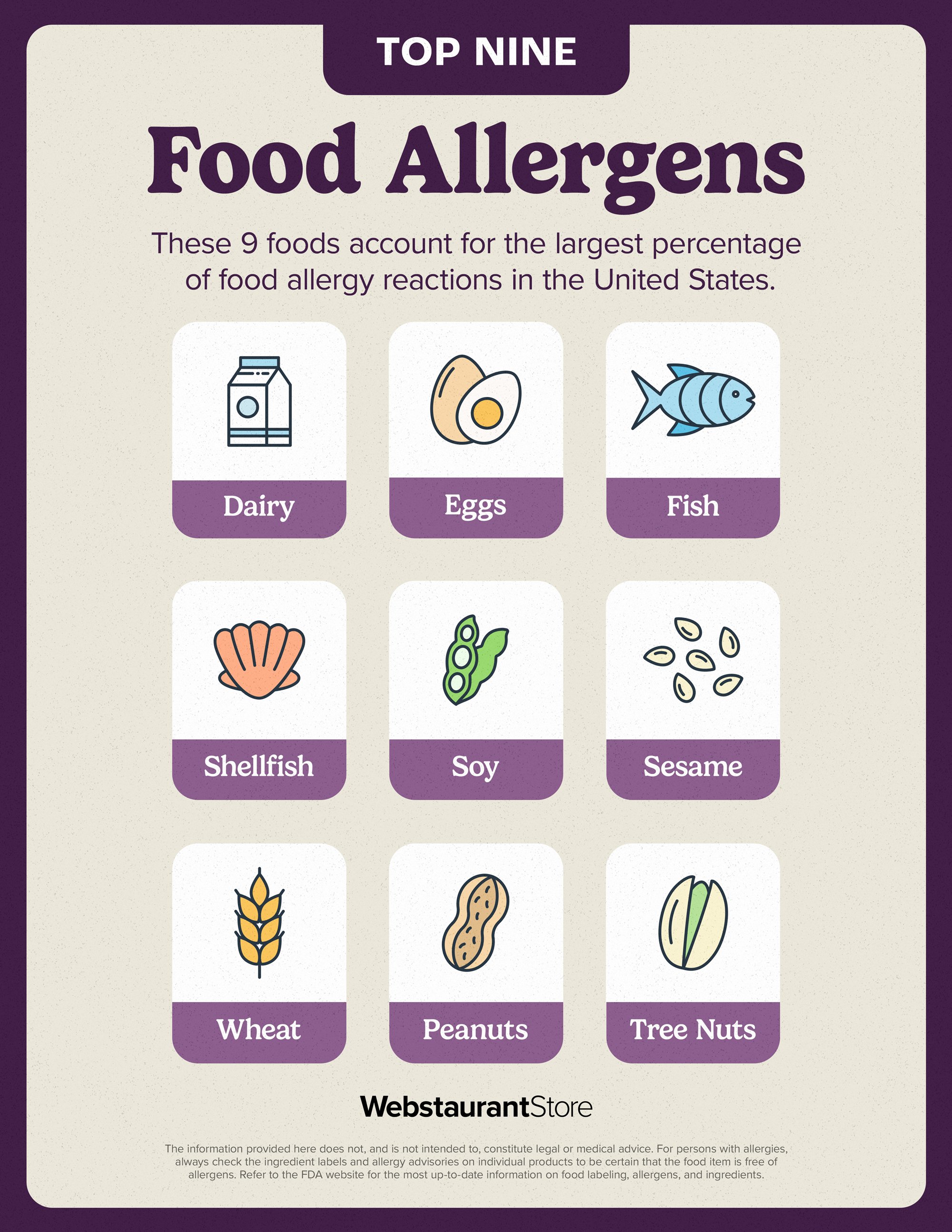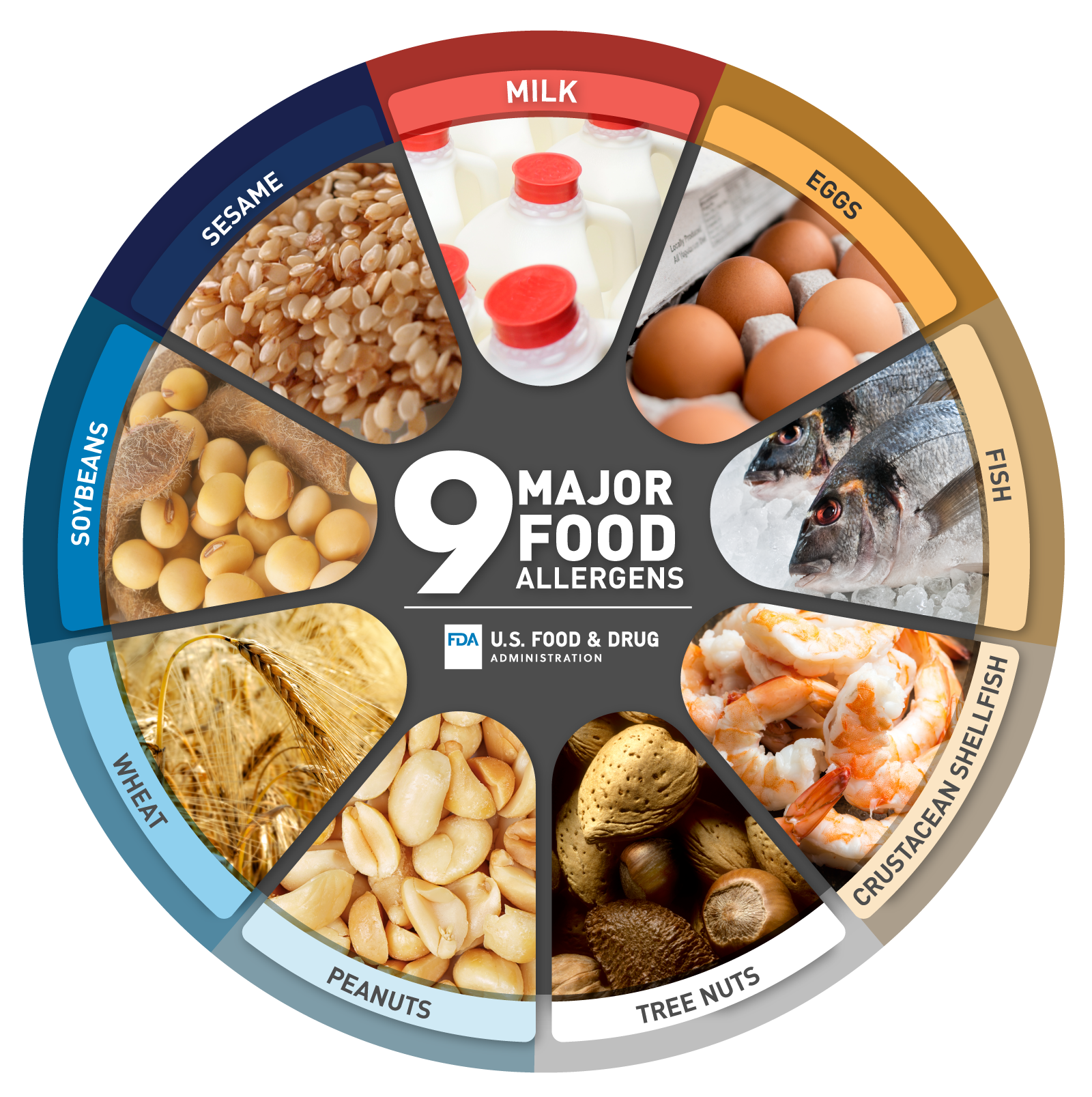The eight most common food allergies are milk, eggs, peanuts, tree nuts, fish, shellfish, soy, and wheat. These foods account for the majority of allergic reactions.
Understanding food allergies is crucial for both consumers and food service professionals. Allergies can be life-threatening, making awareness and caution integral to meal planning and food preparation. The 'Big Eight' allergens listed are responsible for around 90% of allergic reactions related to food, prompting strict labeling laws and the development of allergy-friendly alternatives.
Prevalence of these allergies varies, with some like peanut allergies being more common in children, who may outgrow them, while others persist into adulthood. Avoiding trigger foods is essential for those affected, and this necessitates clear communication within the food industry and vigilant reading of food labels by consumers. Knowledge of these key allergens empowers individuals to manage their dietary needs safely and effectively.

Credit: www.amazon.com
Rise Of Food Allergies Globally
The world is seeing more people allergic to foods than ever before. Knowing the most important allergies food list helps stay safe. Parents and children now often worry about what's for lunch. This rise in food allergies affects everyday choices and health.
Recent Statistics
Global data paints a concerning picture of food allergies today. Numbers are climbing. Research shows that:
- Over 250 million people may have food allergies.
- Children are especially at risk, with allergies in kids increasing at alarming rates.
- The cost for families and healthcare systems grows each year.
Potential Causes
Why are allergies rising? The answer isn't simple, but some factors might explain:
Factor |
Details |
|---|---|
Changes in Eating Habits |
More processed foods could lead to more allergies. |
Hygiene Hypothesis |
Too clean environments might not train immune systems well. |
Vitamin D Deficiency |
Less sun exposure might play a role in rising allergies. |
Globalization |
Exotic foods can introduce unfamiliar allergens. |

Credit: www.webstaurantstore.com
Identifying Common Food Allergens
Food allergies affect millions of people worldwide. Knowing which foods commonly cause reactions can prevent allergic responses. The list of food allergens continues to grow. However, some culprits stand out more than others. This section delves into the well-known and emerging allergens causing stir. Each item in these lists plays a crucial role in managing the dietary needs of those with sensitivities.
The Big Eight
These allergens account for about 90% of all food allergies:
- Milk: Affects children mostly, but can continue into adulthood.
- Eggs: Common in children; many outgrow it by adolescence.
- Peanuts: Can cause severe, potentially fatal reactions.
- Tree Nuts: Include almonds, walnuts, and cashews among others.
- Soy: Found in many processed foods. Often confused with a less severe intolerance.
- Wheat: Not to be confused with gluten intolerance or celiac disease.
- Fish: Shellfish included, can cause severe allergic reactions.
- Shellfish: Distinct from finned fish, and can be highly allergenic.
Emerging Allergens
Attention is widening to new allergens. Awareness is key to safety:
- Sesame: Becoming more recognized for its allergenic potential.
- Corn: Challenging to identify due to its prevalence in processed foods.
- Mustard: More common as an allergen outside the U.S., attention is rising.
- Meat: Rare but concerning, with red meats as common triggers.
- Fruit and vegetables: Raw forms can trigger oral allergy syndrome.
- Spices: Vary widely. Reactions can be difficult to pinpoint.
Allergy Vs Intolerance
Understanding the reaction our bodies have to certain foods is key to managing our health. Knowing the differences between food allergies and intolerances helps us make better dietary choices. Let's dive into what sets them apart and how to identify them.
Defining The Differences
Food allergies involve the immune system, while food intolerances do not. An allergy triggers a response where the body mistakenly identifies a protein in food as harmful. An intolerance usually comes from an inability to properly digest certain substances. A classic example of intolerance is lactose intolerance, where individuals lack the enzyme to digest lactose found in dairy products.
Consequences And Symptoms
Allergy Symptoms |
Intolerance Symptoms |
|---|---|
|
|
Symptoms of allergies can appear quickly, sometimes within minutes. Intolerance symptoms may take longer to show, and can vary in severity. Allergies can be life-threatening; intolerances generally are not. However, both can diminish quality of life and deserve attention.
Diagnosing Food Allergies
Identifying food allergies can be a complex process. It often involves a combination of medical tests and personal tracking to pin down the foods that cause reactions.
Medical Tests
Doctors use specific tests to diagnose food allergies. These tests can provide clear insights into how your body reacts to certain foods.
- Skin prick test: Small amounts of suspected allergens are placed on your skin. A positive reaction causes a bump, similar to a mosquito bite.
- Blood test: Checks for antibodies that fight foods you may be allergic to.
- Oral food challenge: Done under medical supervision, you'll consume small portions of potential allergens.
- Elimination diet: You remove foods from your diet and slowly reintroduce them to observe reactions.
Self-observation And Food Diaries
Keeping a detailed food diary aids in recognizing patterns in allergic reactions. Note everything you eat and any symptoms that follow.
Additional rows as needed| Date | Food Consumed | Symptoms | Time After Eating |
|---|---|---|---|
| April 1 | Scrambled eggs | Itchy skin | 30 min |
Analyze this diary with a specialist to identify potential food allergies. With careful tracking and professional help, managing allergies becomes easier.
Living With Dietary Restrictions
Living with dietary restrictions can transform routine meal planning into a careful strategy. The most common food allergens - such as nuts, dairy, and gluten - can trigger serious reactions. It’s essential to navigate this landscape with knowledge and vigilance. Below, learn key tactics for managing allergenic foods.
Reading Labels
Understanding labels is your safety shield against allergens. The law requires that companies list common allergens. Look for bold or italicized words. These often indicate allergy info. Some terms may be confusing. For example, "casein" is a milk protein. You must learn these terms to recognize allergens.
Allergen-free products often have certifications. Seek the "gluten-free" or "nut-free" labels for quick identification. Keep in mind that terms like "natural flavors" can hide allergens. Always contact manufacturers if in doubt. This ensures you make safe, informed choices.
- Check for bolded allergens
- Learn alternative names for allergens
- Look for certifications
- Watch out for vague terms
- Contact manufacturers with concerns
Kitchen Cross-contamination
Cross-contamination can happen in your own kitchen. Always use separate utensils for allergen-free cooking. This includes cutting boards, pans, and toasters. Even small traces of food can cause a reaction.
Equipment |
Action |
|---|---|
Cutting boards |
Use dedicated boards for allergen-free prep |
Pans & pots |
Clean thoroughly or have separate sets |
Toasters |
Designate a specific toaster for gluten-free bread |
Don't forget to clean surfaces after preparing allergenic foods. Wipe counters with soap and water. Always wash hands thoroughly before touching allergen-free foods. Educate family and guests about these practices.
Store allergen-free foods separately. Use clear labels on storage containers to avoid mix-ups. Vigilance in the kitchen can ensure a safe dining environment for those with food allergies.
- Use separate utensils and appliances
- Clean all surfaces well after use
- Label and store foods clearly
Safe Alternatives And Substitutes
Finding safe alternatives and substitutes for allergy-inducing foods is essential. Whether dealing with common allergies like nuts, dairy, or gluten, there are tasty options. This guide helps you enjoy meals without fear.
Plant-based Options
Many people must avoid dairy and eggs. Plant-based choices come to the rescue. These substitutes are not only safe, but they're also delicious and nutritious.
- Milk: Almond, oat, soy, and rice milk are creamy and full of flavor.
- Butter: Try spreads made from olive oil, coconut, or avocados.
- Cheese: Nutritional yeast or cashew spreads mimic cheese's taste.
Gluten-free And Beyond
Wheat allergies demand a gluten-free diet. Fear not, because plenty of gluten-free options exist. They not only avoid gluten but often offer added health benefits.
- Bread: Choose options made with almond flour or coconut flour.
- Pasta: Rice noodles or quinoa pasta make great alternatives.
- Snacks: Check labels, but many rice cakes and popcorn are safe choices.
| Regular Flour | Gluten-Free Alternative |
|---|---|
| All-Purpose Flour | Rice Flour |
| Wheat Flour | Buckwheat Flour |
| Barley Flour | Almond Flour |
Remember, exploring new food options opens the door to exciting flavors. Your diet can be both allergy-safe and adventurous. Check labels for cross-contamination to stay safe. Your taste buds and health will thank you!
Emerging Treatments And Therapies
The fight against food allergies is advancing. Scientists develop new treatments and therapies. They aim to help millions of people. Their goal is to reduce allergic reactions to foods.
Oral Immunotherapy
Oral Immunotherapy (OIT) is a promising approach. It gradually increases the body's tolerance to allergens. Patients consume small amounts of the allergenic food. Starting with a tiny amount, the dose slowly increases over time. Under the guidance of healthcare professionals, this may lead to reduced allergic symptoms.
- Increases tolerance to food allergens
- Supervised by allergy specialists
- May help children and adults
Future Prospects
Research continues to find better treatments. Scientists are looking into vaccines for food allergies. They also explore ways to retrain the immune system. Here are some areas they are working on:
| Area of Research | Potential Impact |
|---|---|
| Biologics | May help manage the immune response |
| Probiotics | Could balance gut bacteria, help with allergies |
| Epigenetics | May unveil how to switch off allergy genes |
| Nanoparticles | Could carry allergens to teach the immune system |
These new methods could change lives. Experts believe they will greatly reduce the risk of food allergies. Hope grows for safer futures for those affected.

Credit: www.fda.gov
Conclusion
Understanding your food allergies is crucial to staying healthy and safe. This list offers a starting point for recognizing common allergens. Always read labels and communicate with your healthcare provider for personalized advice. Remember, managing allergies is about staying informed and vigilant.
Embrace a proactive approach to your dietary needs and thrive.


